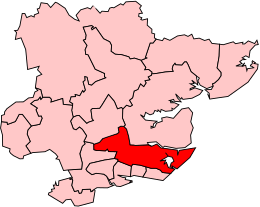Rochford (UK Parliament constituency)
Rochford was a County Constituency in Essex, represented in the House of Commons of the Parliament of the United Kingdom from 1983 until 1997. It elected one Member of Parliament (MP) by the first past the post system of election.
| Rochford | |
|---|---|
| Former Borough constituency for the House of Commons | |
 Rochford, showing boundaries used from 1983-1997 | |
| County | Essex |
| 1983–1997 | |
| Number of members | One |
| Replaced by | Rayleigh, Rochford and Southend East, Maldon and Chelmsford East |
| Created from | Chelmsford, Maldon, South East Essex, Southend East |
History
The seat was created for the 1983 general election from parts of the Maldon, Chelmsford and abolished South East Essex constituencies. It was abolished at the next redistribution which came into effect for the 1997 general election, when it was largely replaced by the new constituency of Rayleigh, with the town of Rochford itself being included in the new constituency of Rochford and Southend East.
It was held by Michael Clark for the Conservatives throughout its existence.
Boundaries
The District of Rochford, and the Borough of Chelmsford wards of Ramsden Heath and Downham, Rettendon and South Hanningfield, Runwell, Woodham Ferrers North, and Woodham Ferrers South.[1]
The District of Rochford comprised the former Rural District of Rochford, which had been part of the Maldon constituency, and the former Urban District of Rayleigh, which had been part of the abolished South East Essex constituency. The Borough of Chelmsford wards had previously been in the Chelmsford constituency.
On abolition in 1997, the bulk of the constituency formed the new constituency of Rayleigh, with Rochford and Great Wakering being included in the new constituency of Rochford and Southend East.
Members of Parliament
| Election | Member[2] | Party | |
|---|---|---|---|
| 1983 | Michael Clark | Conservative | |
| 1997 | constituency abolished: see Rayleigh, Rochford and Southend East & Maldon and Chelmsford East | ||
Elections
Elections in the 1980s
| Party | Candidate | Votes | % | ± | |
|---|---|---|---|---|---|
| Conservative | Michael Clark | 29,495 | 57.8 | −3.28 | |
| Liberal | Richard Boyd | 16,393 | 32.15 | +14.11 | |
| Labour | Hyman Witzer | 5,105 | 10.01 | −10.83 | |
| Majority | 13,102 | 25.69 | |||
| Turnout | 50,993 | 73.49 | |||
| Conservative win (new seat) | |||||
| Party | Candidate | Votes | % | ± | |
|---|---|---|---|---|---|
| Conservative | Michael Clark | 35,872 | 60.4 | +2.6 | |
| Liberal | Philip Young | 16,178 | 27.3 | −4.8 | |
| Labour | David Weir | 7,308 | 12.3 | +2.3 | |
| Majority | 19,694 | 33.1 | +7.4 | ||
| Turnout | 59,358 | 78.0 | +4.5 | ||
| Conservative hold | Swing | ||||
Elections in the 1990s
| Party | Candidate | Votes | % | ± | |
|---|---|---|---|---|---|
| Conservative | Michael Clark | 38,967 | 61.1 | +0.7 | |
| Liberal Democrats | Nicholas Harris | 12,931 | 20.3 | −7.0 | |
| Labour | Donald Quinn | 10,537 | 16.5 | +4.2 | |
| Liberal | Linda Farmer | 1,362 | 2.1 | New | |
| Majority | 26,036 | 40.8 | +7.7 | ||
| Turnout | 63,797 | 83.0 | +5.0 | ||
| Conservative hold | Swing | +3.8 | |||
Notes and references
- "The Parliamentary Constituencies (England) Order 1983". www.legislation.gov.uk. Retrieved 2019-09-09.
- Leigh Rayment's Historical List of MPs – Constituencies beginning with "R" (part 2)
- "'Rochford', June 1983 up to May 1997". ElectionWeb Project. Cognitive Computing Limited. Archived from the original on 8 March 2016. Retrieved 8 March 2016.
- "Politics Resources". Election 1992. Politics Resources. 9 April 1992. Retrieved 2010-12-06.